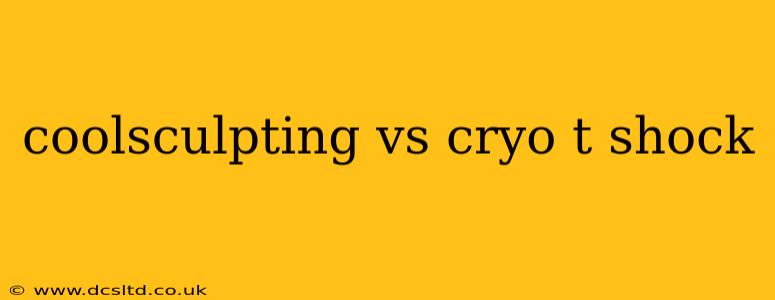Fat freezing, or cryolipolysis, has become a popular non-invasive cosmetic procedure for reducing stubborn fat deposits. Two prominent methods are CoolSculpting and Cryo T Shock. Both aim to eliminate fat cells through controlled cooling, but they differ in their technology and approach. This comprehensive guide will help you understand the key distinctions to make an informed decision about which treatment best suits your needs.
What is CoolSculpting?
CoolSculpting is a well-established brand name for cryolipolysis, using a patented cooling technology to freeze and eliminate fat cells. The procedure involves applying applicators to the targeted areas, freezing the fat cells below their survival temperature. These damaged cells are then naturally processed and eliminated by the body over several weeks. CoolSculpting is FDA-cleared for multiple areas of the body, including the abdomen, flanks, thighs, and chin.
What is Cryo T Shock?
Cryo T Shock represents a newer generation of cryolipolysis technology. It utilizes a combination of cryolipolysis and radiofrequency (RF) energy. The cooling aspect targets fat cells for elimination, while the RF energy helps to tighten and contour the skin, offering potential benefits beyond just fat reduction. Cryo T Shock often boasts shorter treatment times compared to CoolSculpting.
CoolSculpting vs. Cryo T Shock: Key Differences
Several key factors differentiate CoolSculpting and Cryo T Shock:
Technology:
- CoolSculpting: Primarily uses cooling technology to freeze and destroy fat cells.
- Cryo T Shock: Combines cryolipolysis with radiofrequency energy for both fat reduction and skin tightening.
Treatment Time:
- CoolSculpting: Typically requires longer treatment sessions per area.
- Cryo T Shock: Often features shorter treatment times due to the combined technology.
Cost:
- CoolSculpting: Generally considered more expensive per treatment area.
- Cryo T Shock: May be a more budget-friendly option, but pricing varies depending on the clinic and the number of areas treated.
Results:
- CoolSculpting: Delivers gradual fat reduction visible over several weeks.
- Cryo T Shock: May offer faster visible results due to the skin tightening effects of RF energy, though the ultimate fat reduction may be similar to CoolSculpting.
Which Treatment is Better?
There's no single "better" treatment; the ideal choice depends on individual needs and preferences.
-
Choose CoolSculpting if: You prefer a well-established, FDA-cleared technology with extensive clinical data supporting its efficacy. You're comfortable with longer treatment sessions.
-
Choose Cryo T Shock if: You prefer a potentially faster treatment with the added benefit of skin tightening. You're looking for a potentially more budget-friendly option.
How Long Does It Take to See Results?
CoolSculpting: Visible results typically appear gradually over several weeks, with optimal results seen within 2-3 months.
Cryo T Shock: Some improvement might be noticed sooner due to the RF energy's skin tightening effect, but the full fat reduction will still take weeks to months.
Is There Downtime with Either Procedure?
Both CoolSculpting and Cryo T Shock are non-invasive procedures with minimal downtime. You may experience some redness, swelling, or bruising at the treatment site, but these are typically temporary and resolve within a few days.
Are CoolSculpting and Cryo T Shock Safe?
Both procedures are generally considered safe when performed by qualified and experienced professionals. However, as with any medical procedure, potential risks and side effects exist. It's crucial to discuss these with your doctor before undergoing treatment.
What are the Potential Side Effects?
Possible side effects for both procedures may include temporary redness, swelling, bruising, numbness, or pain at the treatment site. Rarely, more serious complications can occur; hence, choosing a qualified practitioner is crucial.
Choosing between CoolSculpting and Cryo T Shock requires careful consideration of your individual needs, budget, and desired outcomes. A consultation with a qualified medical professional will allow you to discuss your goals and determine which treatment is best suited for you. Remember, realistic expectations are crucial for a successful outcome.
